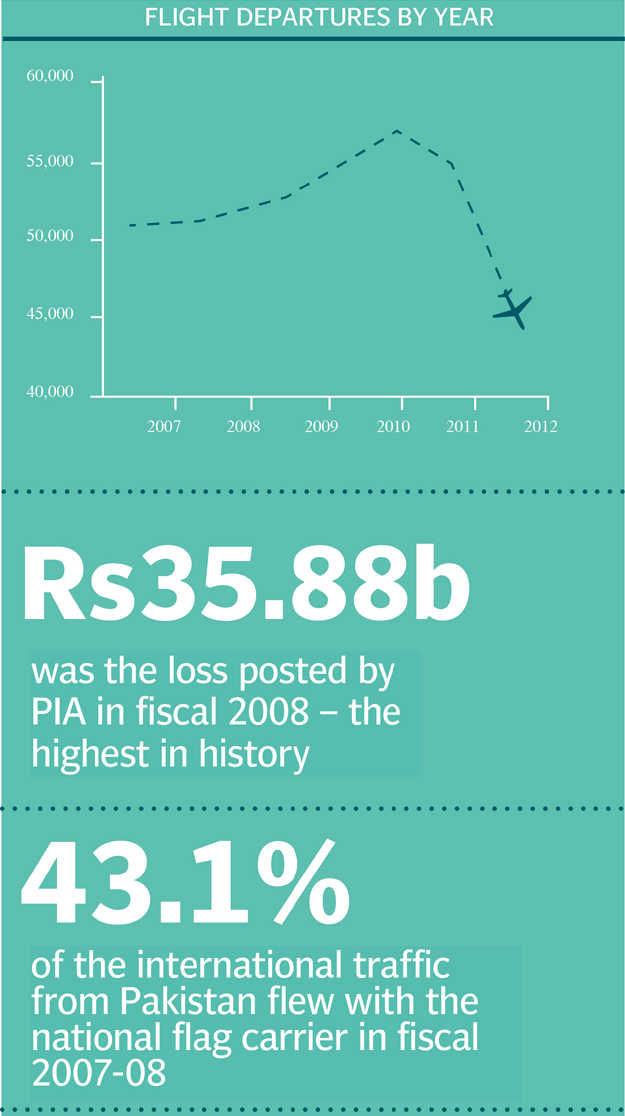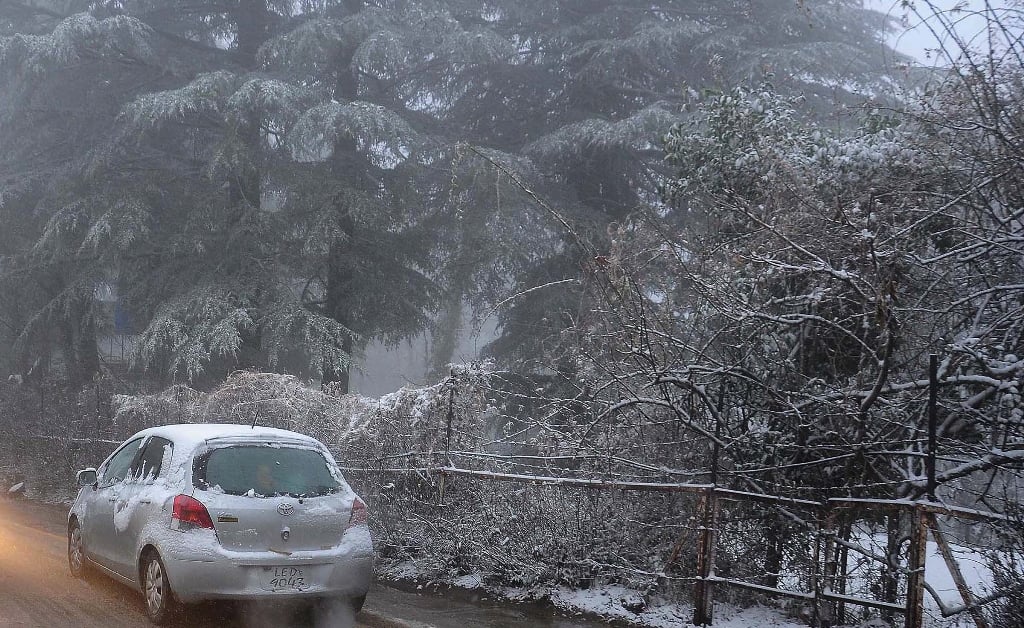
The entire story of the Pakistan International Airlines (PIA) can be summed up with these letters: AP-BCD. That is the registration number of a Boeing 737, which PIA leased to Emirates in 1985 to start operations. After 28 years PIA is still flying it, struggling to fund replacement, while the Dubai-based carrier has built one of the most modern fleets in the world.
This is an of-repeated fact in the PIA. Employees love to talk about it, reflecting upon the past glory of the airline which is now bleeding over Rs30 billion a year.
It is difficult to analyse the PIA problem in the light of passenger traffic, yield, cost per employee, available seat kilometres (ASK) and available tonne kilometres (ATK). No matter how hard one tries, everything boils down to some sort of emotional, not rational, conclusion as drawn by thousands of employees and millions of its loyal passengers.

References are made of the legendary Air Marshal Nur Khan, the two-time managing director, and the airhostess Momi Gul Durrani, called ‘The Face of PIA’.
During discussions, former managers bang their heads on the table swearing PIA turnaround is possible in a year. They accuse government of giving precedent to politics in appointing successive chief executive officers. Employees point fingers at incompetent managers. Consultants say half of the workforce is a drag on the airline.
Since 2001, PIA posted profits only in 2002 to 2004 period. Like all the legacy carriers, be it Air India or Lufthansa, PIA has suffered from ever-increasing fuel costs, inherent inefficiencies and lack of capital injection when it was needed the most.
Ahmad Saeed was the last MD to steer PIA into profits. “We asked General Pervez Musharraf to support us and let us do what we wanted to do. Our loans were restructured and from a loss of Rs2.2 billion in 2001, the airline made a profit of Rs1.8 billion in the following year,” Saeed said.
But was that turnaround possible without government support? Probably not! Saeed’s management convinced Islamabad to arrange a bailout package of Rs20 billion, which meant payment off long-pending loans, plugging interest drain and cash equity injection of Rs8.82 billion.
PIA used the equity injection to lease three Boeing 777-200 and six Airbus 310 aircraft in 2004. It was after 13 years that the airline inducted planes to its aging fleet. New planes allowed the airline to start flights to Chicago, Toronto and London.
But that was also the year when airlines around the world started to feel the impact of rising fuel prices. For Pakistani carriers there was an additional problem of rupee depreciation which was slowly creeping up but had yet to cause major damage.
In subsequent years, CEOs will partially blame debt repayment burden, piled up due to acquisition of B-777s, in spoiling the financial statements. Altogether, PIA acquired nine B-777s at a cost around $1.5 billion.
“Unfortunately, all the loans were locked in dollars and the rupee depreciation was not foreseen (to hurt) at that time,” said Ahmad Saeed. “We were not allowed to forward-book dollars at that time.”
There was another change that took place. “Real fault for this mess lies with the open skies policy. We also faced the problem when Emirates was being allowed just two additional flights. But we asked the government to shoot down the proposal.”

The year 2005 was a watershed. Jet fuel price shot up from Rs71.68 per gallon to Rs102.05 – a 42% jump in a year. Tariq Kirmani, who is widely credited for reshaping Pakistan State Oil (PSO), took charge from Saeed. But it was a shock, which would not let PIA recover in the coming years as fuel ate over 40% of revenues.
More worries lay ahead. On July 10, 2006, PIA’s Fokker crashed in Multan, necessitating it to ground all Fokker planes and expediting their replacement with twin turboprop ATRs – that meant an additional $100 million in debt.
In March 2007, European Union authorities banned PIA’s B-747 and A-310 from flying to member states, leaving the airline with just B-777s for high-yield markets.
As the Pakistan People’s Party (PPP) government came to power in the following year, restrictions on labour unions were eased. Strongman Captain Aijaz Haroon was appointed as the MD.
Oil surged to over $147 a barrel in July 2008, forcing airlines to completely change their ways. The year also saw global financial meltdown with bad repercussions for Pakistani rupee, which went down 28%.

“That was the time airlines had parked their aircraft to save fuel costs. PIA should have cut back on loss-making routes aggressively but that didn’t happen,” said a former director of marketing.
Still in fiscal 2007-08, PIA was carrying 43.1% of the international traffic from Pakistan, followed by the second highest market shareholder Emirates at 14%.
That was also the worst year for the national flag carrier as it posted a loss of Rs35.88 billion. It was also the time the government started drip-feeding the airline by helping it to arrange loans, most of which were used to pay vendors and salaries.
Industry officials blame this myopic approach for many of the ills. Government should have made a capital injection like it did in 2003. That would have helped it buy desperately needed narrow body aircraft, they say.
As airlines around the world were slashing costs by sacking employees, cutting weight of the aircraft and managing the fleet efficiently- the management of PIA was embroiled in a tussle with unions.
Credit goes to Aijaz Haroon under whose tenure PIA recorded marginal operating profit of Rs720 million in 2010, reflecting better utilisation of fleet.
The ultimate finale came as Haroon had to resign in February 2011 when employees went on a strike against a proposed agreement with Turkish Airlines to code share the routes.
In the last two years, PIA has gone completely to the verge of collapse with the government giving it piecemeal support to meet day-to-day expenditure of billions, demanding neither better performance from the management or giving money for newer aircraft.
Now, with a fleet of 38 planes, PIA can operate just 25. Often it does not even have money to pay for spares. In any case, operating old planes like B-747s mean loss.
Shortage of planes for small-haul operations within the country or flights to Gulf States forced PIA to use B-777s. “That’s criminal. You can’t use a B-777 on domestic routes. Its landing gear needs to be changed after fixed hours whether it goes to Lahore from Karachi or Paris,” said an aviation expert.
For years, PIA has relied on a loyal customer base, arguing they will help it remain afloat no matter what. That might just be changing. In 2007-08, private airline Shaheen Air International carried just 280,615 passengers. In the last fiscal year, it flew over one million people. PIA has not moved an inch.
1946
Orient Airways starts flying with two DC 3s
1955
Government incorporates Orient into Pakistan International Airlines
1955
First international flight flies to London via Cairo and Rome
1959
Air Marshal Nur Khan takes over PIA leadership
1960
PIA becomes Asia’s first jet operator by acquiring B-707
1961
First trans-Atlantic flight goes to New York
1964
Commercial flights to Beijing, becoming first only non-communist carrier to do so
1965
PIA provides logistic support to military during the war
1971
PIA loses some of its assets after seperation of East Pakistan
1973
Nur Khan called to resume leadership during crisis
1981
First financial bailout from govt
1985
PIA acquires six B 737-300s
1991
PIA gets first of six A-310s – last addition for next nine years
1999
PML-N govt removed along with MD Shahid Khaqan Abbasi
2002
PIA returns to profitability after a long time
2004
Receives delivery of first B-777
2006
Fokker crashes in Multan killing 45 people onboard
2007
EU imposes ban on PIA aircraft
2008
PIA books highest ever losses of Rs36 billion
2011
MD Aijaz Haroon resigns after labour protest
2013
Government decides to privatise PIA
Published in The Express Tribune, September 30th, 2013.
Like Business on Facebook, follow @TribuneBiz on Twitter to stay informed and join in the conversation.
COMMENTS (22)
Comments are moderated and generally will be posted if they are on-topic and not abusive.
For more information, please see our Comments FAQ























For those prople who insist that PIA can be turned around in one year, all I can say is that they live in a fool's paradise. You need a turn around specialist to acomplish such a miracle, and you can find many with proven track records, at home and abroad. If we can hire sports coaches from overseas then why not one for PIA as well, that is if we need one. None of the last four MD and the current DMD are trained to run a business as large as an airline. They neither have the education nor the vision to run a business which is global in nature in as much as you have to comptete against airlines from all over the world which are run by highly skilled people with huge experience in management, finance and operations.
Our current management has always claimed that theirs is the right vision for resurrecting the airline, but vision without implementation is simply hallucination.
FK
Privatization is a step in right direction. For a complete turnaround of PIA, we need to have a professional management with no govt infuence. The professional management can make rationale decisions for selection of routes, aircrafts, booking systems errors, high staff - that are the major causes of downfall. We have seen turnaround of institutions which were in extremely bad shape like HBL, UBL, MCB, & UBL - now they are all having record profits and good customer service. Same is with PTCL.
I hope the process of privatiosation is materialised without any political influence
If it was so easy to turn around PIA then why should Pam Am TWA and their likes have failed as they were all operating in the private sector, so the bottom line is that once a business has lost goodwill and the competition provides a better product recovery is not possible PIA's product is only two/three flights per week to most destinations overseas whereas competition is providing two or more flights a day.
last time when I travelled via PIA, the back side of seats were not repaired/replaced but painted with pottery in a way that one should feel they are repaired. I couldn't sleep during the whole journey, thinking if this is situation of seats, how the maintenance of aircraft engine will be done?
However, I feel one difference, the cabin crew was extra ordinary polite unlike many of my flights when I saw Cabin Crew Aunties rudely shouting at passengers.
Why haven't you mentioned the tenure of Rafique Saigol? Wasn't that a golden period for the airline? He opened up several routes including the first flights to China, etc. and was a man of impeccable integrity.
Would you want to fix this disaster called PIA or simply shut it down and start another airline. That leaves all problems with the existing carrier and allows the new one to start afresh. All decent aircraft can be transferred - the lessors wont mind. All good staff can be reemployed. An the airline that comes out, if run properly, would struggle to make a loss, such is the demand for air travel in Pakistan. It can become first choice for all long haul routes, as it will be the only non-stop option.
The reasons for PIA's collapse are the same as the reasons for Pakistan's almost-failed status. Instead of becoming Iqbal's 'Shaheen,' and once envy of many neighboring nations, it has degenerated into the abyss of misery, murder, and mayhem. Shameless corruption, nepotism, provincialism, adherence to false religious affiliations, sense of undue entitlements, oppression of minorities, disregard of educational qualifications and shameless misuse of the quota system to bypass qualified groups of people, and total disregard of rule of law are the main factors for the dismal performance of Pakistan and its' institutions, agencies, political parties, and society. In rare instances in history nations have pulled out of such depth, but it takes an extraordinary revolutionary leader and movement to lead the masses to success. None is in sight for now.
There should be a commission, beyond any political interference, who should have authority to conduct interviews and select people for the post of MD's and CEO's for all state owned enterprises, just like in Malaysia and what Imran Khan suggested.
More stories like this and the PIA stock price will be affordable for poor overseas investors.
We've cannibalised out entire country, how can PIA escape?
army personnel along with govt tried their every bit to loot this airline for since long and they did it successfully..
whether they privatize it or not, i am not sure if people are willing to risk life by flying PIA at current state.
with massive political appointments and hiring people well beyond capacity, i am afraid most of PIA employees don't know how to do their job and probably doing it wrong.
@M.Irfan You forgot 16000+ employees.Half of them are political appointments.PIA plane to crew ratio is out of this world.
The real reason for decline is Peoples Unity. If you overburden a small airline (with only 30 aircrafts) by 15,000 jiyalas then naturally this is what you'll get
RIP
Govt should cleared all the loans of PIA at once which'll save the interest due to PIA . New planes should b got on lease to run on profitable routes to get the amount .
Shut it down or sell it off (if anyone will buy it). PIA offers an inferior product at an expensive price point in a competitive market. Talking about the glory days from 30 years ago when national flag carriers enjoyed monopoly power over key routes and timid competition isnt going to turn things around.
Privatization is the only answer to the current situation of PIA, PR & PSM. Will not only be profitable but they will better serve the nation and with better service.
Government interference will never stop until PIA is privitized and privitization will never succeed until Unions are banned and work force is reduced.
From the data presented in the article, the operations of PIA are unsustainable due to extremely weak financial position of GOP. Ground them immediately. RIP